Since the launch of Sputnik on October 4, 1957, more than 9,000 vehicles have been launched into space, but only about 2,000 of them are currently functioning. The rest burned up in the atmosphere or broke and became "space debris" in orbit.
And Elon Musk is about to launch 12,000 satellites, 260 kg each, into Earth's orbit. And this is just the beginning - then he plans to expand the network to 42,000 units. You understand - in total, this is significantly more than what was launched in the entire history of mankind! And most importantly, he has already begun to do it!
What for? At the very least, satellite Internet is expensive and complicated, and besides, it is not fast enough!
1 MB - $ 5
Therefore, he decided to create his own Internet with blackjack, well, as expected, covering the entire globe with communication and accessible to everyone, and in some ways it can be better than the same optics! Today we will find out if this is possible and will tell you in detail about the "Starlink" project. How does it work what does SpaceX have to do with it!
History
Elon Musk announced Starlink in January 2015. But why are we talking about this now, because something happened, but first, a little about the project and its history
To say that the project is ambitious is to say nothing. After all, Elon in his speech promised that the new satellite network will be able to cover almost the entire territory of our blue ball and provide up to 50% of the bandwidth of all world Internet traffic, thereby revolutionizing the industry!
True, with the clarification that in densely populated places, for example, in big cities, up to 10% of traffic, but still very impressive.
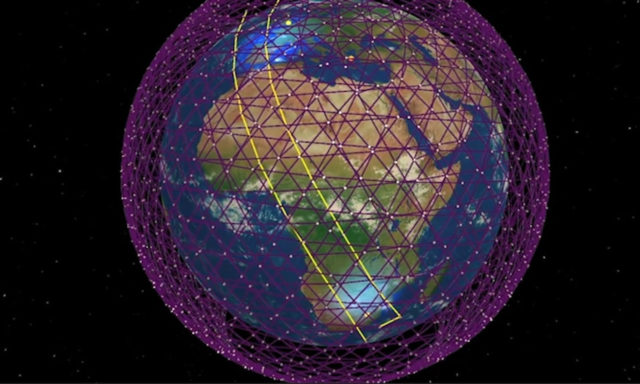
So what's the idea?
First, let's find out what problems satellite Internet has today! For example, one of them is latency. It is huge and is about 500 ms. In CS: GO, you can't drive, and indeed it lags far behind today's requirements for the Internet.
To understand how it arises, we need to understand a little about orbital mechanics! You know that satellites fly at certain distances from the earth, that is, in orbits. There are many of these orbits, they are different and serve for different purposes. For example, the orbit of the International Space Station is about 400 kilometers, and the orbit of GPS satellites is about 20,000 kilometers.
Such an orbit was chosen so that each satellite covers a certain and large area on the planet - after all, the further you are from the Earth, the larger the area you can see.
With Internet satellites, and with most telecommunications satellites, everything is about the same, only they fly even further from the Earth in the so-called Geostationary Orbit at an altitude of about 35,000 kilometers from the Earth's surface.
Such an orbit has advantages - only a few powerful satellites can be launched and they will cover the entire surface of the planet, but naturally there are also disadvantages, the main of which are latency and a relatively low data transfer rate. After all, the signal needs to go back and forth, that is, 70,000 kilometers. This is what gives rise to such a long delay.
I'll tell you a secret, Borya and I worked in a satellite operator - I myself tested this connection and I remember this unfortunate delay. And the most expensive resource was - the same bandwidth on satellites - there are very few of them.
And what did Starlink suggest to solve this problem? Look! Instead of sending several satellites into Geostationary Orbit, they decided to put many small satellites in Low Earth Orbit, that is, at an altitude of about 500 kilometers, which will constantly be in communication with each other and with the Earth. Moreover, they will not hang at one point, but will constantly be in motion.
Well, how many satellites do you need to bring out to create such a living web around the earth?
We already answered at the beginning, but it still blows the mind. I will remind you to start with 12,000 pieces, and then another 42,000. The number is what, not otherwise, an Easter egg from Elon.
And off we go ... SpaceX's first test satellites were launched in 2018. They will not take part in the future network, but they served to test communication systems.
Then, already in May 2019, also in test mode, the first 60 pre-production satellites of version 0.9 were launched, they still did not know how to communicate with each other, but there were already special antennas for communication with the Earth.
But since November 2019, SpaceX has already begun launching serial satellites of the main constellation version 1.0. These are already usable satellites and at the moment there are already 844 satellites in orbit.
And each next launch replenishes the constellation by about 60 satellites at a time.
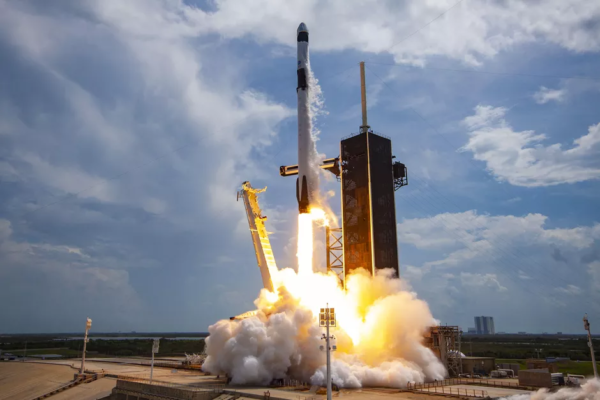
But how is this so, you ask? Then it will take them tens of years to launch these thousands of satellites, if only about 500 were launched in six months.
SpaceX's Starlink satellite launch plans are daunting. First, they plan to launch 60 satellites every 2 weeks by September. Secondly, this number is clearly not final, since one of the goals of SpaceX is the ability to launch the same carrier rocket with intervals between launches of less than a day.
Do you remember that SpaceX learned how to land its boosters on Earth and reuse them? This means there will be more launches ... a lot more!
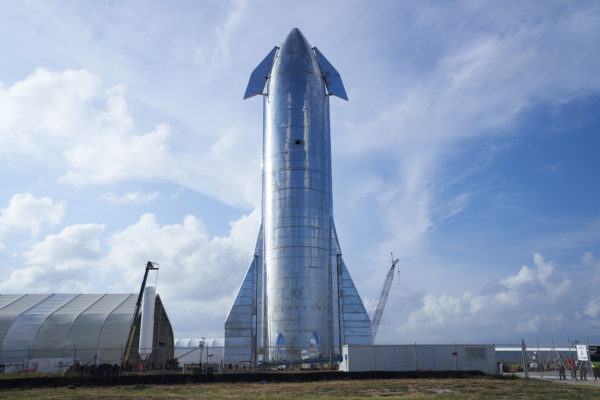
Well, and most importantly - the new super-heavy rocket Starship, which is being developed very actively, according to calculations it will be capable of launching up to 400 Starlink satellites at a time!
How will it work?
Let's just say it already works!
To start the system in full-fledged mode, it is not necessary to display tens of thousands of satellites. In principle, the system already allows itself to be tested, and it was recently possible to apply for a beta test on the Starlink website.
There are now 844 satellites in orbit and, according to Musk, this provides significant operational potential. In fact, a closed beta test is already underway, and since October 27, invitations to an open beta test have been sent out.
But what happened almost exactly a year ago on October 22:
Elon Musk sent the first tweet through the Starlink system!

There are already many measurements of speed - but more on them later.
The full completion of the first phase implies the launch of about 4,000 satellites, which will already provide coverage of the entire planet.
We roughly understood the concept of the network itself, now let's talk about its devices.
About the satellites themselves
But the company does not give details about satellites, but here is information from the data that SpaceX submitted to the US FCC.
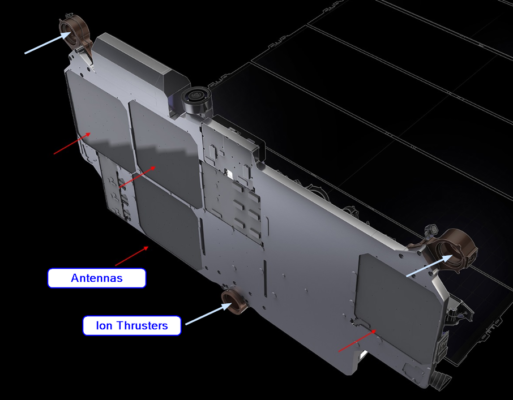
Each satellite is equipped with a laser system and 4 phased antennas. In addition, the satellites have krypton-based ion thrusters, which are needed to change the orbit of the satellites, as well as to naturally burn them in the Earth's atmosphere when their lifespan comes to an end.
Lasers are needed so that satellites can exchange information with each other and, as it were, transmit it like a baton.
Nothing is known about the laser data transmission system itself, except that the satellites will be able to simultaneously communicate with five neighbors.
Imagine that it will be like optical fiber, only without the fiber itself - after all, in space it is not really needed!
Antennas are needed to communicate with user stations on Earth. They need to provide more bandwidth and be able to work with many users at the same time. They are known to operate on the Kei-Alpha and Kei-Yu bands (K u and K a).
And what is a station on earth?
According to Musk himself, this antenna is no larger than a pizza box. And to connect it, you just need to plug it into an outlet and point it to the sky!
That is, for you to understand, the process of tuning the antenna today is not so simple - I remember how I did it myself several years ago!


But let's remember the delay - we remember that it will be significantly lower - but by how much? Get ready!
After the implementation of the first phase, the delay in communication with the satellite will be about three and a half milliseconds.
3 ms by satellite - just imagine and from anywhere in the world!
Compare with the satellite internet we have now. Here the delay is more than 100 times less!
We realized that it will be significantly better than the current satellite Internet, but think further: Starlink will be faster than fiber-optic Internet on Earth!
The Real Engineering Channel gives a very cool example. For whom is low latency important? For gamers? Nothing of the sort - for brokers! Some have the risk of getting a headshot from a fifth grader, while others are risking tens of millions of dollars worth of fucking ping!
Imagine that you are sitting in London and you urgently need to sell your shares on the New York Stock Exchange. Of course, the situation is absolutely daily for each of us!
Through Starlink, the latency will be 43 ms, while using modern Internet this time is about 76 ms. That is, the difference is 77%, and this is a huge number? even though we're talking about milliseconds!
The main thing is that financial markets of the world are ready to pay very big money for such a decrease in delay. If in the past, for the sake of acceleration by only 5 ms, a new fiber-optic cable was laid from the UK to the USA worth 300 million dollars. And this is only from London to New York, and there is also Hong Kong, Singapore, Tokyo. Here the decrease in latency will be even greater!
At the same time, the system is reliable: if any one satellite fails, then the information will simply go along another chain of the web.
That is, not only will the system make it possible to work more reliably and faster, but it will also be available from anywhere in the world. It doesn't matter where - in the center of the Pacific Ocean or in the center of a big city!
In August of this year, the first data from user tests has already appeared. Even with only a small fraction of the number of satellites in question, the speeds already perfectly allow you to upload videos to Instagram or watch videos on YouTube!
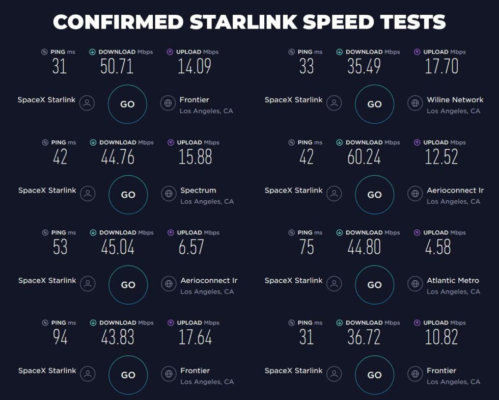
Let's take a look at what they offer testers: $ 499 - a terminal with an antenna and a built-in Wi-Fi router, $ 99 - a monthly subscription fee, Speed: 50-150 Mbit, and a delay of up to 40 ms with an improvement to 20 ms already within a year! For a beta test, it's generally fine. And it is clear that this is not the final price at all. It can easily decline when the project has a large primary user base! And the StarLink app is already available in the Apple Store and Google Play!

Moreover, the first application was found: SpaceX provided firefighters from Washington with two ground terminals of the Starlink system, writes The Verge. It was useful for extinguishing fires in forests, where there is an obvious lack of Internet.
Also, in the future, the system will be useful in other natural disasters, for example, earthquakes, when ground communications are damaged.

But of course not without criticism. The astronomical community has raised concerns that such a number of satellites will greatly affect the information received by telescopes on earth.
Indeed, in 2019, after the launch of the first batch of satellites, 19 of them interfered with the work of the DECam (Dark Energy Survey) telescope for 5 minutes, which is designed to search for traces of dark energy. As a result, the company's engineers got out - they figured out that the satellites should be covered with a special dark coating, which would make them invisible to telescopes.
And so far there is no information about, for example, how strongly the environment will affect the signal, for example, tree crowns, mountains, clouds. But in theory, the more satellites, the less interference will interfere.
As for the cost for subscribers. There are only approximate figures and they sound like this. The cost of a plate is from $ 100 to $ 300 and a subscription fee of $ 80 per month.
This is already much closer to the real prices for the Internet - expensive, but obviously not $ 5 per MB.
But it is clear that with an increase in the number of subscribers and possible future competition with other companies, this cost will clearly decrease! And there are other companies - for example, OneWeb!
And of course people who are afraid of chipping through 5G towers will go crazy with this project!
In general, the system will be constantly improved and improved, but so far there are still many questions.
Let's dream a little about where such a project will lead us. Just imagine - the Internet is everywhere! In the sea in ships, in the sky in airplanes, anywhere! Fast, stable and high quality connection. And let's say, if you insert antennas into the roofs of cars. All this brings us closer and closer to the full implementation of the Internet of Things!
And if you dream and, for example, reduce the “dish” to the size of an antenna in your phone: this is the Internet anytime, anywhere.
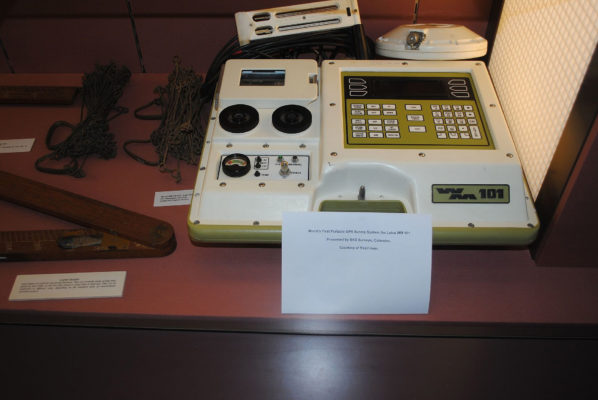
And these are not empty examples - for example, it happened with GPS at one time. The first GPS receiver was not small at all! And now it is already in the wristwatch!
Total

I don't know about you, but I really like the way modern technologies are developing and without a doubt we have entered a new space age!
In addition, Elon Musk has another project - Neurolink, which we are also going to tell you about. It will of course be about that very chipping ...